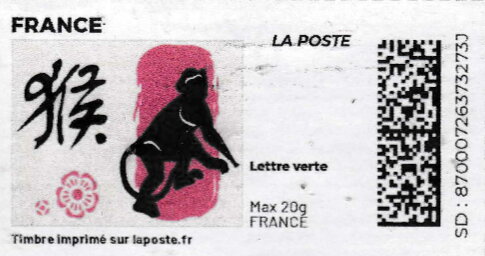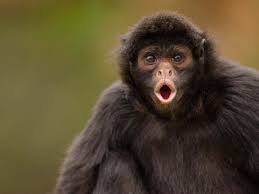Stamp: Chinese New Year of the Monkey. redesign without logo (France 2023)
Chinese New Year of the Monkey. redesign without logo (France 2023)
01 January (France ) within release MonTimbrEnLigne. Astrology goes into circulation Stamp Chinese New Year of the Monkey. redesign without logo face value Lettre No Face Value
| Stamp Chinese New Year of the Monkey. redesign without logo in catalogues | |
|---|---|
| Colnect codes: | Col: FR-TIM 2023-405 |
Stamp is square format.
Also in the issue MonTimbrEnLigne. Astrology:
- Stamp - Chinese new year of the rabbit. Redesign without Lapostelogo face value Lettre;
- Stamp - Chinese new year of the rabbit. Redesign without Lapostelogo face value Lettre;
- Stamp - Chinese new year of the rabbit. Redesign Courrier Suivi face value Prioritaire;
- Stamp - Chinese New Year of the Tiger with red block face value Lettre;
- Stamp - Aquarius Verseau. Redesign without laposte logo face value Lettre;
- Stamp - Chinese new year of the dragon. redesiign without logo face value Lettre;
- Stamp - Chinese new year of the rooster redesign without Laposte log face value Lettre;
- Stamp - Chinese New Year of the Bull. redesign without lapoqtz logo face value Lettre;
- Stamp - Chinese New Year of the Pig Type 1. Rdesign without laogo face value Lettre;
- Stamp - Scorpio Scorpion. Redesign without laposte logo face value Lettre;
- Stamp - Chinese New Year of the Monkey. redesign without logo face value Lettre;
- Stamp - Chinese new year of the goat. red block. redesign, no logo face value Lettre;
- Stamp - Chinese new year of the snake. red face value Lettre;
- Stamp - Chinese new year of the dragon. redesign in black face value Lettre;
- Stamp - Aquarius Verseau. Redesign without laposte logo face value Lettre;
- Stamp - Pisces. Poisson. Redesign without laposte logo face value Lettre;
- Stamp - Nouvel An Chinois 2023 - Année du Dragon face value Lettre;
- Stamp - Chinese new year of the snake. black face value Lettre;
- Stamp - Chinese new year of the snake. black face value Lettre;
- Stamp - Chinese new year of the snake. red face value Lettre;
- Stamp - Chinese new year of the snake. red. Courrier suivi face value Lettre;
- Stamp - Chinese new year of the snake. red. Courrier suivi face value LettreServic100;
- Stamp - Chinese new year of the snake. yellow face value Lettre;
Stamp Chinese New Year of the Monkey. redesign without logo it reflects the thematic directions:
Chinese New Year or the Spring Festival (see also § Names) is a festival that celebrates the beginning of a new year on the traditional lunisolar Chinese calendar. Marking the end of winter and the beginning of spring, observances traditionally take place from Chinese New Year's Eve, the evening preceding the first day of the year, to the Lantern Festival, held on the 15th day of the year. The first day of Chinese New Year begins on the new moon that appears between 21 January and 20 February
Monkey is a common name that may refer to most mammals of the infraorder Simiiformes, also known as simians. Traditionally, all animals in the group now known as simians are counted as monkeys except the apes. Thus monkeys, in that sense, constitute an incomplete paraphyletic grouping; however, in the broader sense based on cladistics, apes (Hominoidea) are also included, making the terms monkeys and simians synonyms in regard to their scope.
The New Year is the time or day at which a new calendar year begins and the calendar's year count increments by one. Many cultures celebrate the event in some manner. In the Gregorian calendar, the most widely used calendar system today, New Year occurs on January 1 (New Year's Day, preceded by New Year's Eve). This was also the first day of the year in the original Julian calendar and the Roman calendar (after 153 BC)



